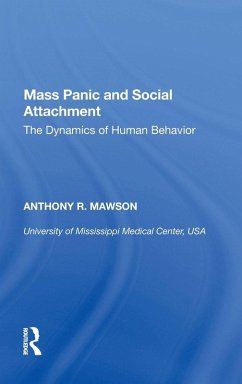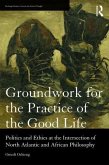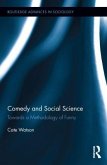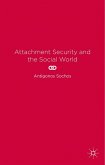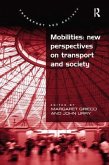- Gebundenes Buch
- Merkliste
- Auf die Merkliste
- Bewerten Bewerten
- Teilen
- Produkt teilen
- Produkterinnerung
- Produkterinnerung
How do humans behave when under threat of attack or disaster? How does the social context affect individual behavior? Anthony Mawson provides an illuminating examination of individual and collective behavior under conditions of stress and danger, in response to both natural and manmade threats and disasters.
Andere Kunden interessierten sich auch für
![Groundwork for the Practice of the Good Life Groundwork for the Practice of the Good Life]() Omedi OchiengGroundwork for the Practice of the Good Life186,99 €
Omedi OchiengGroundwork for the Practice of the Good Life186,99 €![Comedy and Social Science Comedy and Social Science]() Cate WatsonComedy and Social Science176,99 €
Cate WatsonComedy and Social Science176,99 €![Attachment Security and the Social World Attachment Security and the Social World]() A. SochosAttachment Security and the Social World38,99 €
A. SochosAttachment Security and the Social World38,99 €![People, Place, and Attachment in Local Bars People, Place, and Attachment in Local Bars]() John W. McEwenPeople, Place, and Attachment in Local Bars109,99 €
John W. McEwenPeople, Place, and Attachment in Local Bars109,99 €![Attachment Security and the Social World Attachment Security and the Social World]() A. SochosAttachment Security and the Social World38,99 €
A. SochosAttachment Security and the Social World38,99 €![Social representations of Infant Attachment Social representations of Infant Attachment]() Stefania Gutierrez MartinettiSocial representations of Infant Attachment41,99 €
Stefania Gutierrez MartinettiSocial representations of Infant Attachment41,99 €![Mobilities Mobilities]() John UrryMobilities187,99 €
John UrryMobilities187,99 €-
-
-
How do humans behave when under threat of attack or disaster? How does the social context affect individual behavior? Anthony Mawson provides an illuminating examination of individual and collective behavior under conditions of stress and danger, in response to both natural and manmade threats and disasters.
Produktdetails
- Produktdetails
- Verlag: Routledge
- Seitenzahl: 330
- Erscheinungstermin: 29. November 2017
- Englisch
- Abmessung: 240mm x 161mm x 22mm
- Gewicht: 661g
- ISBN-13: 9780815390473
- ISBN-10: 0815390475
- Artikelnr.: 50857371
- Herstellerkennzeichnung
- Libri GmbH
- Europaallee 1
- 36244 Bad Hersfeld
- gpsr@libri.de
- Verlag: Routledge
- Seitenzahl: 330
- Erscheinungstermin: 29. November 2017
- Englisch
- Abmessung: 240mm x 161mm x 22mm
- Gewicht: 661g
- ISBN-13: 9780815390473
- ISBN-10: 0815390475
- Artikelnr.: 50857371
- Herstellerkennzeichnung
- Libri GmbH
- Europaallee 1
- 36244 Bad Hersfeld
- gpsr@libri.de
Anthony R. Mawson is Professor of Preventive Medicine, Division of Epidemiology, University of Mississippi Medical Center, Jackson, Mississippi, USA. He has held teaching, research and administrative posts at universities, hospitals, managed care organizations and in private consulting firm
Contents: Preface
Introduction
Current theories of panic. Part I Theories of Affiliative Behavior: Theories of affiliation
the theory of Walters and Parke
Protection from predators: Bowlby's theory. Part II Toward a Theory of Social Attachment: Arousal and stimulation-seeking: overview
Cognitive maps and susceptibility to influence
Affiliation as stimulation-seeking: a theory of attachment formation
Stimulation-seeking and group dynamics. Part III Panic: Panic as stimulation-seeking
Aggression
The social context of panic
Panic flight as affiliative behaviour
Review of current theories of panic
Havens of safety
Panic as stimulation-avoidance. Part IV: Further Considerations: Two systems of arousal
Towards a neurophysiological theory of emotional behaviour
Summary and conclusions
Understanding mass panic and other collective responses to disaster: update
Appendix: stimulation-seeking and the organization of behavior
Bibliography
Index.
Introduction
Current theories of panic. Part I Theories of Affiliative Behavior: Theories of affiliation
the theory of Walters and Parke
Protection from predators: Bowlby's theory. Part II Toward a Theory of Social Attachment: Arousal and stimulation-seeking: overview
Cognitive maps and susceptibility to influence
Affiliation as stimulation-seeking: a theory of attachment formation
Stimulation-seeking and group dynamics. Part III Panic: Panic as stimulation-seeking
Aggression
The social context of panic
Panic flight as affiliative behaviour
Review of current theories of panic
Havens of safety
Panic as stimulation-avoidance. Part IV: Further Considerations: Two systems of arousal
Towards a neurophysiological theory of emotional behaviour
Summary and conclusions
Understanding mass panic and other collective responses to disaster: update
Appendix: stimulation-seeking and the organization of behavior
Bibliography
Index.
Contents: Preface; Introduction; Current theories of panic. Part I Theories of Affiliative Behavior: Theories of affiliation; the theory of Walters and Parke; Protection from predators: Bowlby's theory. Part II Toward a Theory of Social Attachment: Arousal and stimulation-seeking: overview; Cognitive maps and susceptibility to influence; Affiliation as stimulation-seeking: a theory of attachment formation; Stimulation-seeking and group dynamics. Part III Panic: Panic as stimulation-seeking; Aggression; The social context of panic; Panic flight as affiliative behaviour; Review of current theories of panic; Havens of safety; Panic as stimulation-avoidance. Part IV: Further Considerations: Two systems of arousal; Towards a neurophysiological theory of emotional behaviour; Summary and conclusions; Understanding mass panic and other collective responses to disaster: update; Appendix: stimulation-seeking and the organization of behavior; Bibliography; Index.
Contents: Preface
Introduction
Current theories of panic. Part I Theories of Affiliative Behavior: Theories of affiliation
the theory of Walters and Parke
Protection from predators: Bowlby's theory. Part II Toward a Theory of Social Attachment: Arousal and stimulation-seeking: overview
Cognitive maps and susceptibility to influence
Affiliation as stimulation-seeking: a theory of attachment formation
Stimulation-seeking and group dynamics. Part III Panic: Panic as stimulation-seeking
Aggression
The social context of panic
Panic flight as affiliative behaviour
Review of current theories of panic
Havens of safety
Panic as stimulation-avoidance. Part IV: Further Considerations: Two systems of arousal
Towards a neurophysiological theory of emotional behaviour
Summary and conclusions
Understanding mass panic and other collective responses to disaster: update
Appendix: stimulation-seeking and the organization of behavior
Bibliography
Index.
Introduction
Current theories of panic. Part I Theories of Affiliative Behavior: Theories of affiliation
the theory of Walters and Parke
Protection from predators: Bowlby's theory. Part II Toward a Theory of Social Attachment: Arousal and stimulation-seeking: overview
Cognitive maps and susceptibility to influence
Affiliation as stimulation-seeking: a theory of attachment formation
Stimulation-seeking and group dynamics. Part III Panic: Panic as stimulation-seeking
Aggression
The social context of panic
Panic flight as affiliative behaviour
Review of current theories of panic
Havens of safety
Panic as stimulation-avoidance. Part IV: Further Considerations: Two systems of arousal
Towards a neurophysiological theory of emotional behaviour
Summary and conclusions
Understanding mass panic and other collective responses to disaster: update
Appendix: stimulation-seeking and the organization of behavior
Bibliography
Index.
Contents: Preface; Introduction; Current theories of panic. Part I Theories of Affiliative Behavior: Theories of affiliation; the theory of Walters and Parke; Protection from predators: Bowlby's theory. Part II Toward a Theory of Social Attachment: Arousal and stimulation-seeking: overview; Cognitive maps and susceptibility to influence; Affiliation as stimulation-seeking: a theory of attachment formation; Stimulation-seeking and group dynamics. Part III Panic: Panic as stimulation-seeking; Aggression; The social context of panic; Panic flight as affiliative behaviour; Review of current theories of panic; Havens of safety; Panic as stimulation-avoidance. Part IV: Further Considerations: Two systems of arousal; Towards a neurophysiological theory of emotional behaviour; Summary and conclusions; Understanding mass panic and other collective responses to disaster: update; Appendix: stimulation-seeking and the organization of behavior; Bibliography; Index.

